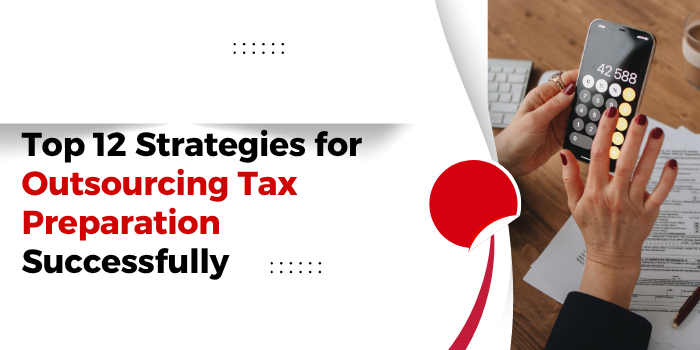 Business
Business
Top 12 Strategies for Outsourcing Tax Preparation Successfully
Let’s face it, tax season brings a surge of pressure. For firms managing multiple clients or businesses juggling internal resources, outsourcing tax preparation can feel like a breath of fresh air.
However, successful outsourcing doesn’t happen by accident. It’s a result of careful planning, partner selection, and smart process integration. Whether you’re a CPA firm expanding capacity or a business owner seeking relief from tax headaches, these strategies will help you outsource with confidence and control.
1. Clarify Your Purpose and Objectives
Before hiring a third-party provider, get crystal clear on why you’re outsourcing. Do you want to increase turnaround times? Eliminate seasonal hiring? Reduce overhead costs? Or gain access to tax specialists?
Defining your goals allows you to:
-
Set realistic KPIs (Key Performance Indicators)
-
Choose the right outsourcing model (onshore, nearshore, offshore)
-
Align expectations with providers from day one
A startup may want to outsource 1099 processing for contractors, while a growing firm might seek full-service business tax preparation services.
2. Use a Pilot Project to Test Compatibility
Don’t leap before you look. Start with a small test run. It’s the safest way to evaluate the provider’s:
-
Technical skills
-
Accuracy levels
-
Communication flow
-
Turnaround time
For instance, outsource the preparation for ten sample returns. Observe how quickly they deliver, whether they understand your documentation, and how they handle feedback.
3. Establish a Data Security Framework
Cybersecurity is non-negotiable when dealing with sensitive financial data. A reputable tax prep partner should follow strict data protection protocols.
Best practices include:
-
End-to-end encryption (AES-256 or higher)
-
VPN-only access
-
Role-based user permissions
-
Regular backups and disaster recovery
-
ISO/IEC 27001 certification or SOC 2 compliance
Never share full login credentials without multi-factor authentication, and use secure file transfer platforms like ShareFile, Dropbox Business, or OneDrive for Business.
4. Key Considerations When Selecting a Provider
Choosing the wrong vendor can cost more than just time—it can impact your compliance standing. To avoid this, assess the provider thoroughly.
Evaluate the provider’s:
-
Years of experience in U.S. tax laws and filings
-
Certifications (CPA, EA, or accredited tax preparers)
-
Industry specialization (e.g., e-commerce, real estate, or healthcare)
-
Familiarity with tax software like Lacerte, UltraTax, or ProSeries
Ask for:
-
A detailed service-level agreement (SLA)
-
Client references and testimonials
-
Portfolio of previous work (with confidential info redacted)
5. Set Clear Expectations and Communication Protocols
Outsourcing doesn’t mean offloading responsibility—it means shared accountability. Communication is the bridge between expectations and results.
To stay on the same page:
-
Define points of contact on both sides
-
Schedule weekly syncs or milestone check-ins
-
Use project management tools like Trello, Asana, or Monday.com
-
Implement real-time chat channels for immediate issues (Slack or Microsoft Teams)
Transparency from both parties builds trust and minimizes the chances of errors or delays.
6. Create a Detailed Scope of Work (SOW)
A scope of work document prevents ambiguity and outlines the working boundaries. Every deliverable should be measurable and defined.
Include in the SOW:
-
Services offered (individual tax returns, business filings, payroll tax prep, etc.)
-
Turnaround times (standard and expedited)
-
Preferred file formats (PDF, Excel, CSV, etc.)
-
Correction and rework policy
-
Reporting frequency and templates
This document becomes your foundation for accountability and auditing.
7. Leverage Technology to Streamline Collaboration
Make your tax workflow cloud-friendly. It speeds up communication, centralizes documentation, and reduces back-and-forth email clutter.
Essential tools to consider:
-
Accounting Software: QuickBooks Online, Xero, Zoho Books
-
Tax Software: Drake, Lacerte, CCH Axcess
-
Document Portals: SmartVault, TaxDome
-
e-Signature: DocuSign, Adobe Sign for signing returns and approvals
You can also integrate these tools using automation platforms like Zapier to trigger tasks or reminders automatically.
8. Use KPIs to Monitor Performance
You can’t improve what you don’t measure. Define and track KPIs to ensure consistent service delivery.
Suggested KPIs for tax prep outsourcing:
-
Accuracy rate: 98% or higher
-
Rework requests: less than 5% of total filings
-
Turnaround time: <48 hours on average
-
SLA adherence: 100%
-
Client satisfaction score: 9/10 or above
Use quarterly reviews to assess your provider’s performance and discuss continuous improvements.
9. Plan for Scalability During Peak Season
Tax season can be brutal. Outsourcing tax preparation helps you flexibly scale your operations without compromising quality.
Checklist for seasonal scaling:
-
Confirm availability of extra tax professionals in Q1
-
Have pre-approved pricing for overflow work
-
Conduct knowledge transfer/training ahead of busy periods
-
Establish a triage system for urgent versus standard filings
Your provider should be able to handle a workload surge without you sacrificing service delivery to your clients.
10. Don’t Neglect Compliance with Local Laws
Even if you outsource overseas, the responsibility for legal compliance stays with you. Ensure your partner is up-to-date with:
-
IRS Circular 230
-
Annual filing deadlines
-
E-filing mandates
-
FATCA, FBAR, and foreign asset rules
Also, ensure they use IRS-compliant methods for document storage and submission.
11. Maintain a Long-Term Relationship
Once you find a great outsourcing partner, don’t treat it as a short-term fix. Long-term collaboration can increase efficiency, reduce handover time, and improve accuracy.
To build long-term synergy:
-
Share feedback and celebrate small wins
-
Involve your vendor in planning sessions
-
Train them on your firm’s evolving policies or niches
-
Provide incentives or bonuses for high-quality work
12. Know When to Switch or Scale Back
Not every partnership pans out. And sometimes, your internal needs evolve. Watch for red flags:
-
Missed deadlines
-
Frequent communication lapses
-
High error rates
-
Poor data security
Conduct annual evaluations. Don’t hesitate to make changes if your business outgrows the provider or their standards slip.
Final Thoughts
Outsourcing tax preparation isn’t just about saving money—it’s about enhancing accuracy, compliance, and business flexibility. When done right, it frees up your internal teams to focus on client relationships, business development, and strategic growth. But success doesn’t come from sending files to the cheapest vendor. It comes from clarity, strategy, and collaboration.
Take the first step with a pilot. Establish systems. Track results. And most importantly, treat your provider as a strategic partner, not just a cost center.
Click here to read more articles: simplychiclife.com









